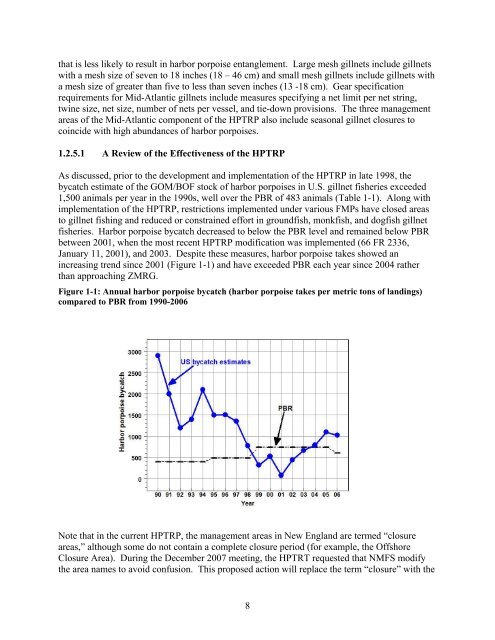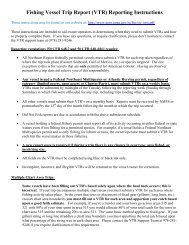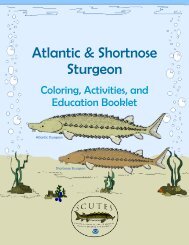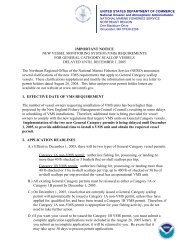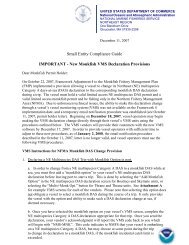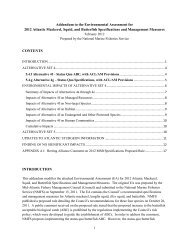modifications to the harbor porpoise take reduction plan - Northeast ...
modifications to the harbor porpoise take reduction plan - Northeast ...
modifications to the harbor porpoise take reduction plan - Northeast ...
Create successful ePaper yourself
Turn your PDF publications into a flip-book with our unique Google optimized e-Paper software.
that is less likely <strong>to</strong> result in <strong>harbor</strong> <strong>porpoise</strong> entanglement. Large mesh gillnets include gillnets<br />
with a mesh size of seven <strong>to</strong> 18 inches (18 – 46 cm) and small mesh gillnets include gillnets with<br />
a mesh size of greater than five <strong>to</strong> less than seven inches (13 -18 cm). Gear specification<br />
requirements for Mid-Atlantic gillnets include measures specifying a net limit per net string,<br />
twine size, net size, number of nets per vessel, and tie-down provisions. The three management<br />
areas of <strong>the</strong> Mid-Atlantic component of <strong>the</strong> HPTRP also include seasonal gillnet closures <strong>to</strong><br />
coincide with high abundances of <strong>harbor</strong> <strong>porpoise</strong>s.<br />
1.2.5.1 A Review of <strong>the</strong> Effectiveness of <strong>the</strong> HPTRP<br />
As discussed, prior <strong>to</strong> <strong>the</strong> development and implementation of <strong>the</strong> HPTRP in late 1998, <strong>the</strong><br />
bycatch estimate of <strong>the</strong> GOM/BOF s<strong>to</strong>ck of <strong>harbor</strong> <strong>porpoise</strong>s in U.S. gillnet fisheries exceeded<br />
1,500 animals per year in <strong>the</strong> 1990s, well over <strong>the</strong> PBR of 483 animals (Table 1-1). Along with<br />
implementation of <strong>the</strong> HPTRP, restrictions implemented under various FMPs have closed areas<br />
<strong>to</strong> gillnet fishing and reduced or constrained effort in groundfish, monkfish, and dogfish gillnet<br />
fisheries. Harbor <strong>porpoise</strong> bycatch decreased <strong>to</strong> below <strong>the</strong> PBR level and remained below PBR<br />
between 2001, when <strong>the</strong> most recent HPTRP modification was implemented (66 FR 2336,<br />
January 11, 2001), and 2003. Despite <strong>the</strong>se measures, <strong>harbor</strong> <strong>porpoise</strong> <strong>take</strong>s showed an<br />
increasing trend since 2001 (Figure 1-1) and have exceeded PBR each year since 2004 ra<strong>the</strong>r<br />
than approaching ZMRG.<br />
Figure 1-1: Annual <strong>harbor</strong> <strong>porpoise</strong> bycatch (<strong>harbor</strong> <strong>porpoise</strong> <strong>take</strong>s per metric <strong>to</strong>ns of landings)<br />
compared <strong>to</strong> PBR from 1990-2006<br />
Note that in <strong>the</strong> current HPTRP, <strong>the</strong> management areas in New England are termed “closure<br />
areas,” although some do not contain a complete closure period (for example, <strong>the</strong> Offshore<br />
Closure Area). During <strong>the</strong> December 2007 meeting, <strong>the</strong> HPTRT requested that NMFS modify<br />
<strong>the</strong> area names <strong>to</strong> avoid confusion. This proposed action will replace <strong>the</strong> term “closure” with <strong>the</strong><br />
8


